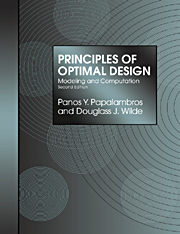2 - Model Construction
Summary
It seems that we reach perfection not when we have nothing more to add, but when we have nothing more to subtract.
Antoine de Saint-Exupéry (Terre des Hommes) (1900–1944)Building the mathematical model is at least half the work toward realizing an optimum design. The importance of a good model cannot be overemphasized. But what constitutes a “good” model? The ideas presented in the first chapter indicate an important characteristic of a good optimal design model: The model must represent reality in the simplest meaningful manner. An optimization model is “meaningful” if it captures trade-offs that provide rigorous insights to whoever will make decisions in a particular context. One should start with the simplest such model and add complexity (more functions, variables, parameters) only as the need for studying more complicated or extensive trade-offs arises. Such a need is generated by a previous successful (and simpler) optimization study, new analysis models, or changing design requirements. Clearly the process is subjective and benefits from experience and intuition.
Sometimes an optimization study is undertaken after a sophisticated analysis or simulation model has already been constructed and validated. Optimization ideas are then brought in to convert an analysis capability to a design capability. Under these circumstances one should still start with the simplest model possible. One way to reduce complexity is to use metamodels: simpler analysis models extracted from the more sophisticated ones using a variety of data-handling techniques.
- Type
- Chapter
- Information
- Principles of Optimal DesignModeling and Computation, pp. 44 - 86Publisher: Cambridge University PressPrint publication year: 2000



